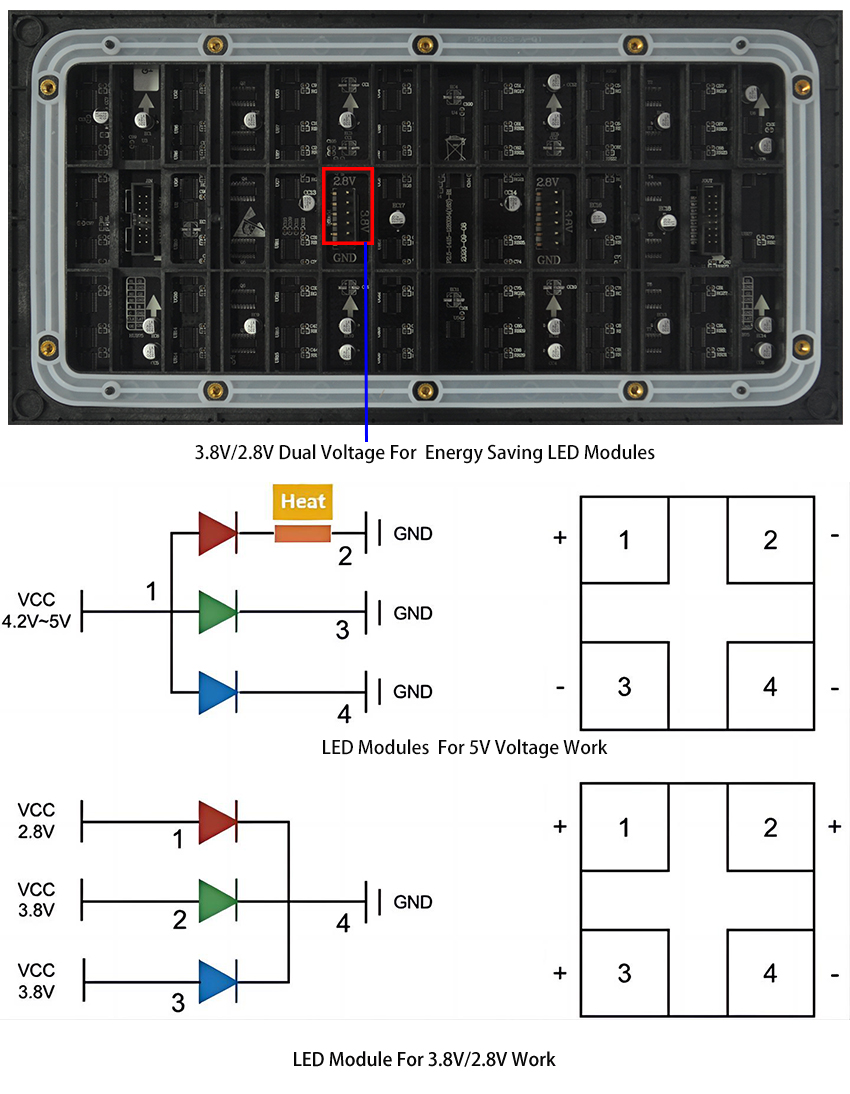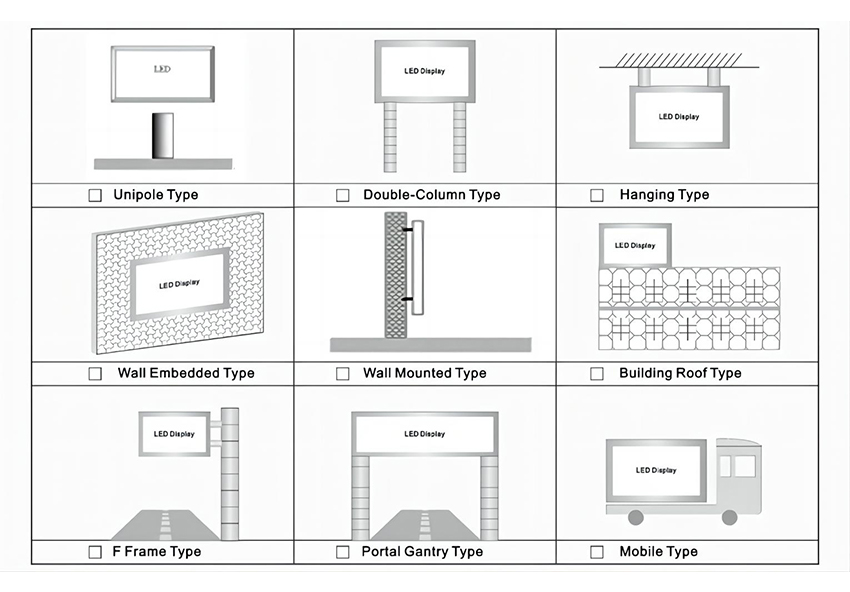
Outdoor LED displays provided by Vision LED are suitable for stadiums, shopping malls, airports, commercial centers, streets, stations, hospitals, banks, supermarkets, and other locations. They can be customized in different sizes and product types according to customer needs.
As a new medium for outdoor commercial display advertising, the outdoor LED display offers high efficiency, energy savings, and a variety of vibrant content. It features strong waterproof performance and long lifespan, ensuring a high return on investment. This makes it ideal for long-term use as a commercial advertising display
In this product page, we will discuss the most important questions and knowledge points about outdoor LED displays. This information will help you choose the right outdoor display product.
1.In Which Scenarios Can An Outdoor LED Display Be Used?
2.What Are The Features Of Outdoor LED Displays?
3.What can an outdoor LED display do for you?
4.How to Install an Outdoor LED Display
5.How to Control an Outdoor LED Display?
6.What are the Components of an Outdoor LED Display?
7.How to Choose an Outdoor LED Display?
1.In Which Scenarios Can An Outdoor LED Display Be Used?
1.1.You can apply outdoor displays in various scenarios, including airports, stadiums, shopping malls, commercial centers, streets, highwaysides, trade exhibitions, parks, tourist attractions, trucks, and many more areas
1.2.This outdoor display supports the playback of various content types, including videos, 3D videos, text, tables, scoreboards, images, weather updates, temperature, humidity, time, and more, enabling diverse content playback options
1.3.Outdoor displays feature high brightness, high waterproofing, and are suitable for a wider range of installation applications compared to indoor displays.
2.What Are The Features Of Outdoor LED Displays?
2.1.High brightness
Outdoor LED displays are installed in outdoor environments where the brightness of sunlight is typically around 3000-5000 cd/m². Therefore, outdoor displays are designed to maintain a brightness of 5000 cd/m² in locations without direct sunlight, and above 6500 cd/m² in positions exposed to direct sunlight. Additionally, customized displays with a brightness of up to 10,000 cd/m² are available.
The control equipment supports external light sensors for automatic brightness adjustment based on daytime and nighttime conditions. It also allows for manual brightness adjustment according to predefined time segments, thus mitigating light pollution.
2.2.high waterproofing capabilities
Outdoor LED display is equipped to withstand harsh rainy and snowy weather conditions. The enclosure features a unique anti-rust and waterproof design, with each unit undergoing rigorous waterproof testing before leaving the factory. The waterproofing rating of the LED enclosure reaches IP65, and for some series, even higher levels of waterproofing at IP66 are achieved.
2.3High-quality image display
Outdoor displays feature high refresh rates, high grayscale levels, and high contrast.High refresh rate: 1920-7680Hz ensures a stable display, meeting the needs of outdoor shooting.High grayscale: 14-16 bits provide a more layered image playback.High contrast ratio: 5000:1 delivers vivid and lifelike images with rich colors.
2.4.Easy Maintenance
Outdoor displays are massive, but for maintenance, we only need to repair one module, saving time and cost. Moreover, the front maintenance design of the enclosure or module makes maintenance more convenient.
2.5.Energy Saving
LED, as a synonym for high efficiency and energy-saving, is renowned for its high brightness, energy efficiency, and long lifespan. Therefore, SMD LED has been widely adopted in outdoor display screens.

3. What can an outdoor LED display do for you?
Outdoor display screens can bring you the following benefits:
3.1. Enhanced Visibility:Increased brand visibility and awareness through dynamic outdoor advertising.
3.2. Greater Engagement: Attract and engage a larger audience with vivid and captivating content.
3.3. Revenue Generation: Generate additional revenue through advertising space rentals or sponsored content.
3.4. Information Dissemination: Effectively convey important information, announcements, or event schedules to the public.
3.5. Environmental Adaptability: Withstand outdoor elements and harsh weather conditions, ensuring continuous operation.
3.6.Cost-Effectiveness: Long-term cost savings due to LED technology's energy efficiency and durability.
4.How to Install an Outdoor LED Display

4.1.Unipole type or Double-Column type :Single or double-pillar installations are typically set up beside roads and busy streets. Their elevated height helps attract customers' attention, thereby increasing the value of commercial advertisements
4.2.Hanging type:Suspended outdoor displays are generally installed at the entrances of malls and stores, typically featuring small outdoor strip screens. These displays attract more customers through their advertising content
4.3.Wall Mounted Type:Wall-mounted installation is a very common method for outdoor displays. This installation method is optimal as it ensures proper heat dissipation and makes future maintenance more convenient. Additionally, the use of 3D video content enhances the screen's impressive performance.
4.4.Building Rood Type:The rooftop installation method provides ample space for easy installation and operation. The height of the building allows advertisements to reach a farther distance, and the rooftop also facilitates better heat dissipation
4.5.F Frame Type or Portal Gantry Type:F-frame and gantry installation methods are typically used beside and above roads to display information such as road directions, weather, climate, temperature, and humidity, as well as images.
4.6.Mobile Type: This installation method involves mounting the display screen on a truck or trailer. A frame is constructed on the truck or trailer to secure the LED display, and a diesel generator is used to power the screen. Utilizing GPS for location-based advertising makes the ad placement more precise
5.How to Control an Outdoor LED Display?
There are two control methods for outdoor displays: synchronous mode and asynchronous mode. Here is a detailed introduction of each:
5.1.Synchronous Mode:
In synchronous mode, the computer and various signal sources transmit signals in real-time to the outdoor display. This ensures that video playback is without delay, and advertising information can be conveyed promptly. Synchronous systems are widely used in rental display screens.
5.2.Asynchronous Mode:
In asynchronous mode, the control system software sends content to a playback box with storage and memory capabilities via WiFi or an Ethernet cable. The playback box then displays the content on the LED screen. Asynchronous systems are the most common control method, using cloud platforms for remote content distribution and display management. This allows for more efficient and centralized management, reducing costs and enabling quick and easy content updates.
6.What are the Components of an Outdoor LED Display?
An LED outdoor screen is a common large-screen display device, typically used for outdoor advertising, performances, sports events, and other occasions. It is composed of the following main part
6.1.LED Module:LED modules are the core components of a display screen, typically using SMD or DIP packaging forms as light sources. They feature high brightness, high contrast, and energy efficiency. Many modules combine to form the panel of an LED display screen.
6.2.LED Cabinet:LED cabinets are used to secure LED modules, LED power supplies, LED receiving cards, and other display screen components. They feature waterproofing and heat dissipation characteristics. The cabinet materials include steel or aluminum, with manufacturing processes such as sheet metal, die-cast aluminum, and extruded aluminum. Additionally, custom sizes, colors, and silk-screened logos are supported
6.3.Power supply:The LED power supply converts the input AC voltage of 220V or 110V into a 5V output working voltage, providing power to various components of the LED display screen.
6.4.Control Systems:The display control system is divided into two parts: the sending system and the receiving system. The sending system includes a sending card or an all-in-one processor, while the receiving system comprises a universal receiving card or a custom receiving card. The control card system is categorized into two different types: synchronous control systems and asynchronous control systems. Synchronous control cards are typically used for rental displays or large-sized screens, whereas asynchronous control systems are generally used for medium to small-sized screens. They enable cluster management and program distribution for the screen.
By utilizing high-quality components and implementing rigorous assembly and testing processes, we provide you with superior products and services.
7. How to choose an outdoor LED display for you?
Choosing a suitable outdoor display screen involves several key factors. Let's guide you step by step to purchase the right screen:
7.1.Your usage requirements: Determine the primary purpose of the display: Whether it's for displaying commercial advertisements, information dissemination, brand promotion, or other needs. Understanding these requirements is essential for making subsequent decisions.
7.2.Location and environment for installation: First, we consider the placement of the outdoor display screen because different installation locations entail different methods and costs. Additionally, outdoor environments experience varying weather conditions, so you should consider the waterproof performance of the display, which is crucial. Furthermore, to prepare for encountering thunderstorms, it's essential to install lightning protection devices to prevent damage to the display screen from lightning strikes.
7.3.Visibility and brightness: In different outdoor orientations and locations, the intensity of sunlight varies. Since the sunlight's intensity is around 4000 nits, the brightness of the display screen generally needs to be above 5000 nits to clearly see the content on the screen. Otherwise, insufficient brightness will result in unclear visibility, reducing the value of advertising. Additionally, you can customize screens with 10,000 nits brightness for installation in environments with strong light.
7.4.Pixel pitch: The display screen is composed of full-color real pixels, which are made up of light-emitting SMD LEDs. The distance between the centers of two SMD LEDs is called the pixel pitch. A smaller pixel pitch results in higher resolution and better image quality. Depending on the viewing distance and the required clarity of the display, you can choose an appropriate LED display.
7.5.Waterproofing and durability: The design and manufacturing of outdoor enclosures need to achieve an IP65 waterproof rating to ensure the protection of internal electronic components. For some special environments, we can also customize display screens with an IP66 waterproof rating, providing even higher waterproof performance.
7.6.Warranty and service: As outdoor display screens are used in harsh weather conditions for long-term outdoor use, it is essential not only to use high-quality products but also to have a long-term warranty and excellent after-sales service. We offer a three-year warranty for outdoor screens to ensure worry-free usage of your screen.
7.7.Energy efficiency: As an outdoor display screen is a long-term media tool, prolonged use will result in electricity costs. You can choose screens with scheduled power on/off and brightness adjustment features to help reduce operating costs. If you have a strong requirement for energy saving, you can opt for outdoor energy-efficient LED display screens, although the procurement cost may be relatively higher.
7.8.Budget: Set a budget for your display screen. Within this budget, try to consider both quality and functionality, as an outdoor LED display is a long-term investment. However, also ensure that the chosen display screen fits within your budget constraints.
With the above information, we hope to help you find the right outdoor LED display. If you have more ideas and requirements, please contact us.
Name: Sales
Mobile:+8613434491929
Tel:+8613434491929
Whatsapp:+8613717008357
Email:[email protected]
Add:Songke Innovation Valley, No. 12, Xunye Street, Songgang Street, Baoan District, Shenzhen